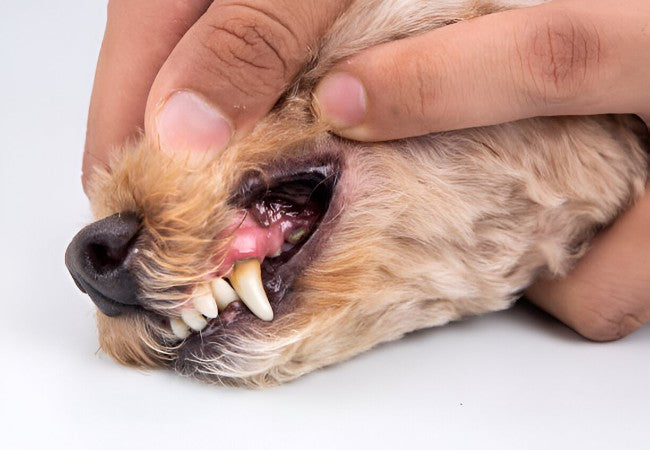Gingival Squamous Cell Carcinoma in Dogs – Vet‑Led Guide 2025 🐶🦷⚠️

In this article
Gingival Squamous Cell Carcinoma in Dogs – Vet‑Led Guide 2025 🐶🦷⚠️
By Dr. Duncan Houston BVSc
Hello, I’m Dr Duncan Houston, BVSc, founder of Ask A Vet. In this thorough 2025 guide, we explore gingival squamous cell carcinoma (SCC)—a common, invasive oral cancer in dogs. Expect expert insights on detection, staging, treatment options, recovery care, and tools to support quality of life. 🧠❤️
📘 What Is Gingival SCC?
Gingival SCC is a malignant tumour of squamous epithelial cells, typically appearing on the gums. It grows rapidly, invades jaw bone but usually metastasizes slowly. Most cases occur in older dogs (~10 yrs), though younger dogs (≥3 yrs) can be affected.
📊 Occurrence & Risk Factors
SCC is the second most common oral cancer in dogs, after melanoma, and accounts for a significant portion of malignant oral tumours in senior dogs (>8 years old).
No strong breed predisposition noted, although overrepresented larger breeds and those with poor oral hygiene may be at higher risk.
🚩 Recognizing Signs & Symptoms
- Ulcerated, raised, irregular mass on the gums, often red or inflamed.
- Drooling (sometimes blood-tinged), bad breath, facial swelling.
- Loose teeth, difficulty eating, weight loss.
- Lymph node enlargement or discomfort when touching the jaw area.
🔬 How Vets Diagnose Gingival SCC
- Oral Examination: Detects mass details, location, and bleeding.
- Biopsy & Histopathology: Confirms SCC and identifies degree of differentiation.
- Imaging: Dental X-rays, CT scans assess bone invasion and tumour margins.
- Staging: Chest X-rays and lymph node aspirates evaluate spread risk.
- Bloodwork: CBC/chemistry panels ensure systemic readiness for therapy.
🎯 Staging & Prognosis
Staging guides treatment decisions:
- Local, rostral tumours: Better prognosis – surgical excision is often curative.
- Lymph node involvement: Present in ~5–10% of cases; distant metastasis to lungs (~10%) is rare.
- Maxillary or caudal tumours: More invasive, slightly poorer outlook.
💉 Treatment Options
1. Surgery (First‑Line 🛡️)
Wide surgical excision with clean margins is the gold standard. Rostral tumours yield excellent outcomes when completely removed.
2. Radiation Therapy
Used when surgery is incomplete or the tumour location is challenging. Provides local control and pain relief.
3. Chemotherapy & Piroxicam
Though not as effective alone, NSAIDs like piroxicam and platinum-based chemo may help, especially in advanced cases.
4. Photodynamic Therapy
Promising results—around 73% remission in some cases—offering less invasive alternative.
5. Emerging Therapies
Immunotherapy and vaccines are experimental but may be future options.
📅 Survival & Prognosis Statistics
- Median survival post-surgery: ~44 months; slightly less for maxillary cases (~39 months).
- Dogs without lymph node spread have significantly longer survival.
- Color digital SCC (like on toes): median survival ~1000 days; oral SCC slightly less.
- Juvenile oral SCCs (dogs <2 yrs) treated early have excellent prognosis.
🏥 Post‑Op Care & Home Management
- Pain relief via NSAIDs or opioids.
- Soft food diet, small, frequent meals.
- Oral hygiene routines to reduce infection.
- PET afternoon: enrichment toys from Woopf & Purrz to reduce stress 🧩.
- Monitor incision, appetite, weight, face swelling.
- Regular checkups at 2 weeks post-op, then every 3–6 months with imaging.
🏠 At‑Home Monitoring Guide
- Brush teeth/bum check weekly.
- Log mealtime behavior and drooling.
- Watch for halitosis, bleeding or swelling.
- Ensure clean water, especially if on NSAIDs.
- Keep dental checkups consistent.
🐾 Integrating Support: Ask A Vet
Need real-time help? Consult Ask A Vet anytime for guidance on symptoms, medications, or healing concerns.
🔑 Key Takeaways
- Gingival SCC is aggressive but treatable—early detection is essential.
- Wide-margin surgery offers the best outcome; radiation or adjunct therapies can help in select cases.
- Home recovery thrives with pain management, diet, hygiene, and enrichment.
- Prognosis is optimistic when nodal spread is absent—many live 2–4+ years post-treatment.
If you suspect an oral growth or after tumor removal, consult your vet or Ask A Vet. We’re here to support your dog’s healing journey every step of the way.






